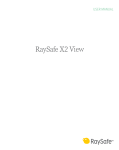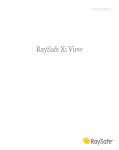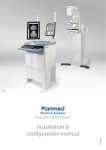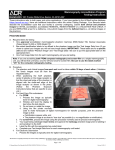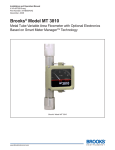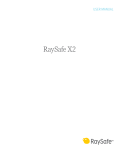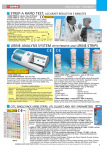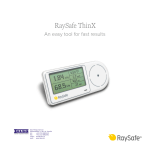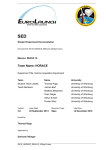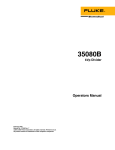Download RaySafe Solo - RaySafe Media Bank
Transcript
User Manual RaySafe Solo © 2013.01 Unfors RaySafe 5001053-C All rights are reserved. Reproduction or transmission in whole or in part, in any form or by any means, electronic, mechanical or otherwise, is prohibited without the prior written consent of the copyright owner. 2 RaySafe Solo User Manual – Contents Contents Introduction..................................................................................................... 5 Versions............................................................................................................ 5 About this user manual.................................................................................... 5 The RaySafe Solo............................................................................................... 6 The RaySafe Solo detector options................................................................. 6 Easy to use........................................................................................................7 Getting Started..................................................................................................8 Keys on the RaySafe Solo base unit................................................................8 Battery and Charger........................................................................................ 9 R/F Measurement.............................................................................................. 10 Mammography Measurement........................................................................ 13 CT Measurement............................................................................................... 16 How to measure CT dose............................................................................... 16 Light Measurement.......................................................................................... 19 mA/mAs Measurement..................................................................................... 22 Passive mAs................................................................................................... 25 Measurement definitions............................................................................. 26 Dose............................................................................................................... 26 Dose Rate....................................................................................................... 28 kV/kVp............................................................................................................ 28 Time................................................................................................................ 29 Pulse............................................................................................................... 30 HVL (Half Value Layer) – optional................................................................. 30 Total Filtration – optional............................................................................... 31 mA and mAs.................................................................................................... 31 RaySafe Solo PC kit......................................................................................... 32 RaySafe Xi View............................................................................................. 32 Transfer data to a computer.......................................................................... 33 Installing RaySafe Xi View............................................................................. 33 3 RaySafe Solo User Manual – Contents Setup of Bluetooth communication............................................................... 33 Getting help....................................................................................................34 Accessories...................................................................................................... 35 The RaySafe flexi stand................................................................................. 35 The RaySafe OPG holder............................................................................... 35 The RaySafe Cassette holder........................................................................ 36 Tips and Tricks..................................................................................................37 Arrangement of Measurement.......................................................................37 Vertical Detector Placement.......................................................................... 38 kVp on AMX.................................................................................................... 38 Display Codes................................................................................................ 38 Frequently Asked Questions......................................................................... 39 Troubleshooting.............................................................................................. 41 Warranty, Service and Support...................................................................43 Service............................................................................................................43 Return Procedure for Service and Warranty..................................................43 Disposal..............................................................................................................44 4 RaySafe Solo User Manual – Introduction Introduction Versions This user manual covers the following articles: base unit version: 8221011 detector version: 8221022 8222015 8222016 8222017 8222018 8222019 8222020 8222021 8222022 About this user manual This user manual is intended to assist users in the safe and effective operation of the product described. Before attempting to operate the product, you must read these instructions for use, noting and strictly observing all WARNINGS and CAUTION notices. WARNING A WARNING alerts you to a potential serious outcome, adverse event or safety hazard. Failure to observe a warning may result in death or serious injury to the operator or patient. CAUTION A CAUTION alerts you to where special care is necessary for the safe and effective use of the product. Failure to observe a caution may result in minor or moderate personal injury or damage to the product or other property, and possibly in a remote risk of more serious injury, and/or cause environmental pollution. NOTE Notes highlight unusual points as an aid to an operator. These Instructions for Use describe the most extensive configuration of the product, with the maximum number of options and accessories. Not every function described may be available on your product. 5 RaySafe Solo User Manual – The RaySafe Solo The RaySafe Solo The RaySafe Solo consists of a base unit and a detector. Communication between detector and base unit is purely digital, thereby minimizing sensitivity to mechanical or electrical stress. The RaySafe Solo detector options • The R/F detector has two sensors: R/F high is designed for conventional, high dose rate measurements. R/F low is designed for low dose rate measurements. The RaySafe Solo R/F base unit can be equipped with mA/mAs capabilities. • The MAM detector is used for both low and high dose rates generated in mammography applications. • The MAM dose detector is a Solo MAM detector, but measures only dose, dose rate and time. • The Dose detector is an R/F detector, but measures only dose, dose rate, time and pulses. • The RAD detector is designed for conventional, high dose rate measurements normally generated without a phantom between the detector and the X-ray source. • The CT detector is an ionization chamber, designed to measure CT dose for applications such as Dose Length Product (DLP) and Computed Tomography Dose Index (CTDI). • The DENT detector is designed for measurements on intraoral dental X-ray machines, OPG and Cone beam. • The light detector is designed to measure luminance on LCD and CRT monitors, as well as light boxes, and illuminance for diagnostic X-ray applications. • There is also a RaySafe Solo mAs model for measuring mA/mAs, time and pulses. 6 RaySafe Solo User Manual – The RaySafe Solo Easy to use The RaySafe Solo is very easy to use. The built-in active compensation automatically applies corrections for different beam qualities, filtrations and temperatures. During fluoroscopy measurements the displayed values are continuously updated. If your instrument is equipped with the RaySafe Solo PC kit, data is sent on the serial port to your computer, where RaySafe Xi View shows numerical data as well as waveforms. 7 RaySafe Solo User Manual – Getting Started Getting Started 1. Connect the detector to the base unit with one of the two (2 and 10m) cables. 2. Position as required for the detector, see the following chapters. 3. Turn on the RaySafe Solo (ON/OFF key, see below), and the instrument specific setup information is displayed. In the SENSOR MENU a detector or sensor field for your application can be selected. 4. The instrument is now in MEASURE MODE and ready to measure. Press STEP to scroll through measured parameters (also possible during fluoroscopy). The last three displayed parameters will automatically show up after the next exposure. To change setup values (SETUP MENU) such as various delays, displayed units and other choices, press SELECT. Keys on the RaySafe Solo base unit ON/OFF: Turns on the RaySafe Solo and off when in SENSOR MENU. EXIT: Exit to the previous menu. STEP: A short press steps through available options. SELECT: A long press selects an option. 8 RaySafe Solo User Manual – Getting Started Battery and Charger The RaySafe Solo base unit has a chargeable 7.4 V Li-ion battery, providing approximately 20 – 40 hours of operation (depending on selected detector and whether Bluetooth is used). Since chargeable batteries have a self discharge current, RaySafe strongly recommends fully charging the battery before first use. Battery level is displayed, together with setup information, when the instrument is switched on. There are two battery warning levels: • First warning level, “Battery low”: Finish your measurements and then charge the battery. • Second warning level, “Battery down”: No further measurements are recommended. The provided battery charger may be connected during measurement. When connected, the external power indicator is lit and Charging battery will be briefly displayed. The battery will be charged even if the instrument is turned off. The charge time from empty to full is approximately 4 hours. 9 RaySafe Solo User Manual – R/F Measurement R/F Measurement Using R/F, RAD, Dose or DENT version. For best accuracy, center the selected sensor field (R/F low, R/F high, RAD, DENT low or DENT high) and position the long axis of the sensor field perpendicular to the anode-cathode axis of the tube. 1. SENSOR MENU R/F low (R/F and Dose) Sensor for conventional low dose rate measurements < 1 mGy/s (7 R/min), normally after a phantom. R/F high (R/F and Dose) Sensor for conventional high dose rate measurements > 1 mGy/s (7 R/min), normally before a phantom. RAD Sensor for conventional high dose rate measurements > 0.1 mGy/s (0.7 R/min), normally before a phantom. DENT low Sensor for low dose rate measurements < 1 mGy/s (7 R/min), normally after a phantom or for applications with high (> 10 mm Al or equivalent) inherent filtration. DENT high Sensor for high dose rate measurements > 1 mGy/s (7 R/min), normally before a phantom. Press STEP to step between sensors and SELECT to select a sensor. 10 RaySafe Solo User Manual – R/F Measurement 2. MEASURE MODE After an offset adjustment, the instrument is in MEASURE MODE. The displayed values are updated after each exposure, or continuously after 4 seconds of fluoroscopy. kVp kVp (for the R/F high, RAD or DENT high sensor at adequate signal levels) or kV (R/F low or DENT low). (Not available on RaySafe Solo Dose.) Dose Gy (Air kerma, free in air) or R (Exposure) Dose rate Gy or R per s, m or h Time ms, s HVL mm Al (only with optional HVL kit) Pulses pulses Total filtration mm Al (included in the optional HVL kit) mAs mAs (requires RaySafe Solo R/F with mAs) mA mA (requires RaySafe Solo R/F with mAs) 3. SETUP MENU Press SELECT to enter the SETUP MENU (from MEASURE MODE) and STEP to step between setup parameters. 11 RaySafe Solo User Manual – R/F Measurement All values are stored in a non-volatile memory and are valid until manually changed. At start up (after the battery status information), valid Trig delay, kVp delay and Calc. delay are displayed in sequence. (Factory settings in bold.) Trig delay A delay in ms after the normal trig of the instrument. Utilize when an unwanted part of an exposure, such as a pre-pulse, should be excluded from the measurement. No measurements are performed during the Trig delay. (0, 5, 10, 50, 100, 200, 500, 1000, 2000 ms) Trig level Use Trig level to measure correct exposure time on waveforms with slowly increasing output, such as with single phase dental. The default setting is a low value, that depends on the selected sensor; see Specifications. Can be set to 25, 50 or 75 % of the peak value of the previous exposure. Use it with the same generator settings and FDD. Not selectable before the first exposure or at low dose rates. kVp delay Defined as the delay in ms, after the trig delay, but before the kVp measurement (and waveform) window begins. Use a kVp delay on machines with slow rising output, such as single phase intra oral machines and fluoroscopy systems. (0, 2, 5, 10, 50, 150, 300, 1000, 1200, 1500, 1700, 2000 ms) Calc. delay Defined as the dead time after end trig, before data is calculated. Default is 0.5 s but it is recommended to use a longer delay when measuring on pulsed fluoroscopy where the time between pulses may exceed 0.5 s. (0.5, 2, 4, 6, 7 s) Dose unit Change the default units and/or use this feature to recalculate a value to a different unit. (Gy or R per s, m or h, where 1 Gy = 114.1 R.) Backlight Display lighting option. (off, 2, 5, 10 s, on) Auto Power Off Never, or after 5, 20 or 60 minutes of inactivity. Info Displays the serial number (S/N) and firmware version of the connected detector and the RaySafe Solo base unit and the calibration date for the selected sensor. There is also a possibility to reset the instrument settings to factory defaults. kVp Mode “kV only” prevents the instrument from calculating kVp, which otherwise occurs automatically when R/F high is selected and the signal level is high enough (“kV/ kVp”). Useful for example when measuring near that signal level. Not applicable for RaySafe Solo Dose. 12 RaySafe Solo User Manual – Mammography Measurement Mammography Measurement Place the detector along the X-ray tube axis (with the cable end pointing towards the X-ray machine). Make sure that the center of the MAM sensor square is placed 6 cm from the examination table front edge. 1. SENSOR MENU Sensor for mammography measurements with submenu for selection of beam qualities, see list to the right (depending on configuration). The choice of “paddle” or “no paddle” only applies if the kV measurement is going to be made with or without a paddle in the beam and does not affect dose or HVL measurements. Mammography Note! Select W/Rh* for measurements on Hologic Selenia and Planmed Nuance. 2. MEASURE MODE The displayed values are updated after each exposure. kV kV (Mo/Mo, W/Rh) (Not available on RaySafe Solo MAM dose.) Dose Gy (Air kerma, free in air) or R (Exposure) 13 Mo/Mo No Paddle Mo/Mo Paddle Mo/Rh Mo/Al Rh/Rh Rh/Al W/Rh No Paddle W/Rh Paddle W/Rh* No Paddle W/Rh* Paddle W/Ag RaySafe Solo User Manual – Mammography Measurement Dose rate Gy or R per s, m or h Time ms, s HVL mm Al (only with optional HVL kit) 3. SETUP MENU Press SELECT to enter the SETUP MENU (from MEASURE MODE) and STEP to step between setup parameters. All values are stored in a non-volatile memory and are valid until manually changed. At start up (after the battery status information), valid Trig delay, kVp delay and Calc. delay are displayed in sequence. (Factory settings in bold.) Trig delay A delay in ms after the normal trig of the RaySafe Xi. Utilize when an unwanted part of an exposure, such as a pre-pulse, should be excluded from the measurement. No measurements are performed during the Trig delay. (0, 5, 10, 50, 100, 200, 500, 1000, 2000 ms) Trig level Use Trig level to measure correct exposure time on waveforms with slowly increasing output, such as with single phase dental. The default setting is a low value, that depends on the selected sensor; see Specifications. Can be set to 25, 50 or 75 % of the peak value of the previous exposure. Use it with the same generator settings and FDD. Not selectable before the first exposure or at low dose rates. kVp delay Defined as the delay in ms, after the trig delay, but before the radiation and kV waveform window (in the RaySafe Xi View) begins. (0, 2, 5, 10, 50, 150, 300, 1000, 1200, 1500, 1700, 2000 ms) Calc. delay Defined as the dead time after end trig, before data is calculated. Default is 0.5 s but it is recommended to use 2 s when measuring on generators with a pre-pulse. (0.5, 2, 4, 6, 7s) Dose unit Change the default units and/or use this feature to recalculate a value to a different unit. (Gy or R per s, m or h, where 1 Gy = 114.1 R) Backlight Display lighting option. (off, 2, 5, 10 s, on) 14 RaySafe Solo User Manual – Mammography Measurement Auto Power Off Never, or after 5, 20 or 60 minutes of inactivity. Info Displays the serial number (S/N) and firmware version of the connected detector and the RaySafe Solo base unit and the calibration date for the selected sensor. There is also a possibility to reset the instrument settings to factory defaults. 15 RaySafe Solo User Manual – CT Measurement CT Measurement The RaySafe Solo CT detector is an ion chamber with a 10 cm active length and a built-in bias voltage. The center and the edges (+ 5 cm and - 5 cm) of the active volume are marked on the phantom adapter. An automatic correction of temperature and pressure will be applied for all dose measurements. The temperature sensor is positioned inside the active ionization chamber and the measurement is corrected for the true temperature inside the phantom. The pressure sensor is placed inside the RaySafe Solo CT detector housing and is calibrated to show the actual pressure at the measurement facility’s altitude. Readings of pressure can therefore vary from announcements in newspapers or web sites, which normally refer to the pressure at sea level. The measured temperature and pressure for each exposure can be displayed when using the RaySafe Xi View. How to measure CT dose Position the RaySafe Solo CT detector in the phantom adapter and then into the phantom position. Turn on the meter and select CT dose. For positioning of the RaySafe Solo CT detector free in air, Unfors RaySafe recommends the use of the RaySafe flexi stand. 16 RaySafe Solo User Manual – CT Measurement 1. SENSOR MENU Ion chamber sensor CT Dose Press STEP to step between sensors and SELECT to select a sensor. Note! When turning on the base unit with the RaySafe Solo CT detector connected, “Stabilizing” will be displayed for a few seconds while the electronics are stabilizing. 2. MEASURE MODE After an offset adjustment, the instrument is in MEASURE MODE. The displayed value is updated after each exposure. Dose Gy (Air kerma, free in air) or R (Exposure) Dose Length Product Gycm or Rcm Note! The RaySafe Solo CT detector can be used in two dose modes (dose or dose length product (DLP)), selectable in the SETUP MENU. Since the RaySafe Solo CT chamber is 10.0 cm long, DLP readings (in Gy•cm or R•cm) will always be exactly 10 times higher than dose readings. 3. SETUP MENU Press SELECT to enter the SETUP MENU (from MEASURE MODE) and STEP to step between setup parameters. All values are stored in a non-volatile memory and are valid until manually changed. (Factory settings in bold.) Dose unit Change the default units and/or use this feature to recalculate a value to a different unit. (Dose: Gy, Gycm, R or Rcm, Temperature: °F or °C, Pressure: kPa or mmHg) 17 RaySafe Solo User Manual – CT Measurement Calc. delay Defined as the dead time after end trig, before data is calculated. Default is 0.5 s but it is recommended to use a longer delay when measuring on pulsed fluoroscopy where the time between pulses may exceed 0.5 s. (0.5, 2, 4, 6, 7 s) Backlight Display lighting option. (off, 2, 5, 10 s, on) Auto Power Off Never, or after 5, 20, 60 minutes of inactivity. Info Displays the serial number (S/N) and firmware version of the connected detector and the RaySafe Solo base unit and the calibration date for the sensor. There is also a possibility to reset the instrument settings to factory defaults. Temperature and pressure values are shown only in the RaySafe Xi View, not on the RaySafe Solo base unit display. 18 RaySafe Solo User Manual – Light Measurement Light Measurement The RaySafe Solo light detector is designed to measure luminance on LCD and CRT monitors, as well as light boxes, and illuminance for diagnostic X-ray applications. The choice between luminance and illuminance is automatic depending on whether the luminance tube is mounted or not. 1. SENSOR MENU Illuminance For illuminance measurements. LuminanceLCD For luminance measurements on LCD. LuminanceCRT For luminance measurements on CRT display, light box or similar. Barco For luminance measurements on Barco monitor. MFGD 5621 HD, MDMG 5121, MFGD 5421, MDCG 3120, MDCG 2121 or MFGD 3621. Press STEP to step between sensors and SELECT to select a sensor. 2. MEASURE MODE Luminance cd/m2 or fL Illuminance lux or fc 19 RaySafe Solo User Manual – Light Measurement Press STEP when in MEASURE MODE to freeze and move the measured value to the second line of the display. A new press on STEP will move a new measured value to the second line of the display. Store the measured value (and send it via the RS-232 interface) in the RaySafe Solo memory by pressing SELECT. A memory counter (Mem #) will be displayed at the very bottom of the display. BARCO STEP • STEP • 3. SETUP MENU Press SELECT to enter the SETUP MENU (from MEASURE MODE) and STEP to step between setup parameters. 20 RaySafe Solo User Manual – Light Measurement All values are stored in a non-volatile memory and are valid until manually changed. (Factory settings in bold.) Offset adjustment To ensure the highest level of accuracy, Unfors RaySafe recommends performing a manual offset adjustment when making luminance measurements below 2 cd/m2 or when making illuminance measurement below 1 lux. Cover the sensor before performing the offset adjustment. Reset memory Resets the memory of 30 luminance or 30 illuminance measurements depending on the selected sensor. The reset is only available if data has been stored in the memory. Send memory Sends the complete data memory of the current sensor via the RS-232 interface. This choice is only available if data has been stored in the memory. Unit Change the default units and/or use this feature to recalculate a value to a different unit. (cd/m2 and lux, or fL and fc) Backlight Display lighting option. (off, 2, 5, 10 s, on) Auto Power Off Never, or after 5, 20 or 60 minutes of inactivity. Info Displays the serial number (S/N) and firmware version of the connected detector and the RaySafe Solo base unit and the calibration date for the selected sensor. There is also a possibility to reset the instrument settings to factory defaults. Hint! Mount the luminance tube and shadow ring. Then position the light detector on a flat and solid surface (like a table) and perform the offset adjustment. 21 RaySafe Solo User Manual – mA/mAs Measurement mA/mAs Measurement Note! It is possible to measure mAs simultaneously with other measurements with RaySafe Solo R/F. The instrument will trig on radiation, not on the current in the RaySafe mAs cable. Any initial rush current will thus be excluded. The measured mAs value automatically appears in MEASURE MODE on the display. 1. Turn off the X-ray generator. 2. Remove the jumper of the mA/mAs port in the generator. 3. Connect the black and red banana plugs of the RaySafe mAs cable to the mA/mAs port of the generator. (Note! The mA/mAs instrument is dependent on the polarity. Using the wrong polarity will result in no trig.) 4. Switch on the X-ray generator. 5. Turn on the RaySafe Solo and select mA/mAs in the SENSOR MENU. Make an exposure and read the measurements in the display. Caution! Do not forget to replace the mA/mAs jumper when removing the RaySafe mAs cable. Caution! Users of the RaySafe mA/mAs meter must be aware of the potential damage to generators and electrical human hazards in case of improper connection or failure of any part of the meter circuit. This feature is intended for use only by personnel authorized in performing calibration and repair of X-ray equipment. 1. SENSOR MENU mA/mAs Circuitry for invasive measurements of mA, mAs, time, pulses. 22 RaySafe Solo User Manual – mA/mAs Measurement 2. MEASURE MODE After an offset adjustment, the instrument is in MEASURE MODE. The displayed values are updated after each exposure or continuously after 4 seconds of fluoroscopy. mAs mAs mA mA Time ms, s Pulses pulses 3. SETUP MENU Press SELECT to enter the SETUP MENU (from MEASURE MODE) and STEP to step between setup parameters. When in the SETUP menu, the active selection will blink. All values are stored in a non-volatile memory and are valid until manually changed. At start up (after the battery status information), valid Trig delay and Calc. delay are displayed in sequence. (Factory settings in bold.) Trig delay A delay in ms after the normal trig of the RaySafe Solo. Utilize when an unwanted part of an exposure, such as a pre-pulse, should be excluded from the measurement. No measurements are performed during the Trig delay. (0, 5, 10, 50, 100, 200, 500, 1000, 2000 ms) Calc. delay Defined as the dead time after end trig, before data is calculated. Default is 0.5 s but it is recommended to use a longer delay when measuring on pulsed fluoroscopy where the time between pulses may exceed 0.5 s. (0.5, 2, 4, 6 s) Backlight Display lighting option. (off, 2, 5, 10 s, on) Auto Power Off Never, or after 5, 20 or 60 minutes of inactivity. 23 RaySafe Solo User Manual – mA/mAs Measurement Info Note! Displays the serial number (S/N) and firmware version of the detector and the RaySafe Solo base unit and the calibration date for the selected sensor. There is also a possibility to reset the instrument settings to factory defaults. It is recommended to use a laptop operating on battery or a Bluetooth connection when capturing waveforms or transferring data to a computer running RaySafe Xi View. Connection of a PC (mains supplied) via a serial cable to the RaySafe Solo base unit may create ground currents affecting the measurement. Be aware of rush currents (loading the capacitance in the high voltage cables) in the initial part of the exposure. Use a Trig delay of 5 ms in the SETUP MENU to exclude the rush current from the measurement, if desired. 24 RaySafe Solo User Manual – mA/mAs Measurement Passive mAs It is possible to measure mAs simultaneously when using the RaySafe Solo R/F with mAs. The instrument will trig on radiation, not on the current in the mAs cable. Any initial rush current will thus be excluded. The measured mAs value automatically appears in MEASURE MODE on the display. On some X-ray equipment the tube current does not drop below 25% of peak at the end of the exposure or the generator give a second current pulse within 0.5 ms. The result is a long time measurement which gives a low mA calculation. These situations are suitable for passive mAs. Follow the steps below to measure passive mAs: 1. Connect the R/F detector to the RaySafe Solo base unit. 2. Connect the mAs cable to the base unit. 3. Connect the black and red banana plugs of the mAs cable to the mA/mAs port of the generator. 4. Place the R/Fdetector in the X-ray field. 5. Make the exposure. 25 RaySafe Solo User Manual – Measurement definitions Measurement definitions Figure 1 illustrates the RaySafe Solo parameter definitions available on a typical waveform. In most situations the default settings are suitable for accurate measurements. In certain situations advanced users can change the measuring definitions of the RaySafe Solo by activating Trig delay and/or Trig level settings. Because the measured parameters will be affected by the settings of delays and trig levels, it is recommended to note the setup information shown on the base unit display at power on. Figure 1. Normal Measurement When an exposure exceeds 4 seconds the measured values are continuously updated in the display. It may take another few seconds to get stable readings (synchronized with the frame rate). Dose The RaySafe Solo R/F, MAM, MAM dose, RAD, Dose and DENT detectors measure dose with a multi-segment sensor, and the Active compensation feature automatically corrects the displayed dose (and dose rate) for beam qualities with an HVL of 1 – 14 mm Al (for example: a filtration of 45 mm Al at 140 kVp gives an HVL of about 13 mm Al). The CT meter is an ionization chamber with carbon fibre housing. It has a flat energy dependence curve and automatic pressure and temperature correction. 26 RaySafe Solo User Manual – Measurement definitions The dose is accumulated from the start trig point plus Trig delay until the end trig. Figure 2. Trig delay activated Note! The trig level setting (25, 50 or 75 %) affects the dose measurement. Note! The backscatter protection of the RaySafe Solo sensor may cause differences in readings compared to ion chambers. If both are placed directly against an object, i.e. image receptor or lead apron, the RaySafe Solo will read lower compared to an ion chamber. However the RaySafe Solo detector will be reading True Input Dose while the ion chamber is reading the input dose plus back scatter from the object directly behind it. If using the RaySafe Solo detector and an ion chamber in free air they should be comparable ± both meter tolerances. 27 RaySafe Solo User Manual – Measurement definitions Dose Rate The RaySafe Solo calculates dose rate as dose/exposure time if the exposure time is less than 6 seconds. After an exposure longer than 6 seconds, a dose rate value recorded approximately 2 seconds before end trig will be displayed. Figure 3. Pulsed fluoroscopy kV/kVp The RaySafe Solo calculates kVp on the R/F high, RAD or DENT high sensor if the signal level is high enough, otherwise kV average will be displayed. If no kVp value is displayed, try decreasing the FDD or increasing mA. kVp is calculated within the kVp measuring window. The kVp measuring window begins after Trig delay and kVp delay and is approximately 160 ms wide. If the exposure time is less than 6 seconds, kV average is the integrated average of the kV values during the whole measurement. After an exposure longer than 6 seconds, a kV value recorded approximately 2 seconds before end trig will be displayed. After the exposure, kV (or kVp if available) is displayed and a waveform is transmitted to the RaySafe Xi View. The RaySafe Xi View also gives a possibility to increase the length of the waveform window. kVp matches kV on high frequency or DC like waveforms. If there is a ripple on the waveform, a kV value will be lower than kVp. 28 RaySafe Solo User Manual – Measurement definitions Figure 4. kV and kVp Table: Active compensation on kV measurements Sensor Filtration kV/kVp R/F low Max. 15 mm Al kV R/F high RAD Max. 15 mm Al kVp (when signal level is high enough) DENT low Max. 1 mm Cu or equivalent kV DENT high Max. 1 mm Cu or equivalent kVp (when signal level is high enough) Use a kVp delay on machines with a slow rising output. 150 ms on dental single phase machines and 1000 ms on a fluoroscopy machine is recommended. kV is available for R/F, MAM, RAD and DENT detectors. Time The RaySafe Solo measures time from the start trig (may be adjusted with the Trig level setting) until the signal falls below 25 % of the peak (50 or 75 % if adjusted with the Trig level setting). At low dose rates (about 1 % of the max dose rate for the active sensor), the 25 % end level is changed to a low level (about the lowest measurable dose rate for the active sensor). If the radiation has a pulsed characteristic, the time is measured until the last pulse ends. The dead time interval between pulses must, however, be less than the Calc. Delay time (0.5, 2, 4, 6 or 7 s). The R/F low or DENT low sensor has an electrical bandwidth of 0.1 kHz (slower rising and falling slopes), causing the displayed exposure time to be a few milliseconds longer than for the R/F high or DENT high sensor, which has a bandwidth of 2.5 kHz. 29 RaySafe Solo User Manual – Measurement definitions Figure 5. 75 % trig level activated (figure also applies to 25 and 50 % trig level settings). Please note that the trig level setting affects the dose measurement. Single phase generators (normally dental applications) may have slowly increasing amplitude characteristics for approximately 100 ms. It is then recommended to activate a higher trig level in the SETUP MENU after the first exposure. Pulse The RaySafe Solo counts pulses from 1 to 9999. The trigger to increment the pulse counter occurs when the dose rate has a negative slope and the amplitude falls below 25 % of the peak amplitude for the exposure. At peak dose rates of approximately < 3 µGy/s (for R/F low) the signal to noise ratio is too low to count pulses and “---” will be displayed. If possible, increase the mA and/or kVp to increase the radiation output or decrease the FDD. Pulse is available for the R/F, RAD, Dose, DENT and mA/mAs detectors. HVL (Half Value Layer) – optional The RaySafe Solo calculates HVL as a function of the signals from several sensor elements from the whole exposure, if exposure time is less than 6 seconds. If the exposure is longer than 6 seconds, a HVL value recorded approximately 2 seconds before end trig will be displayed. 30 RaySafe Solo User Manual – Measurement definitions HVL is an indication of the beam quality and is defined as the amount of Al filtration, measured in mm, needed to reduce the dose in half. HVL is kVp dependent and HVL should not be confused with total filtration. HVL is available for R/F, MAM, MAM dose, RAD, Dose and DENT detectors equipped with the HVL kit option. Total Filtration – optional Total filtration is a calculation of the amount of physical filtration between the X-ray source and the patient, expressed in equivalent amount of mm Al. The total filtration value measured may differ from the filtration stated by the X-ray manufacturer, as there might be additional filtration not specified by the manufacturer. mA and mAs The RaySafe Solo is capable of measuring mA, mAs and time. If the peak mA is > 8 mA, it can also measure pulses, frame rate and mAs per pulse. When an exposure longer than 6 seconds has ended, a mA value recorded approximately 2 s before end trig is displayed. 31 RaySafe Solo User Manual – RaySafe Solo PC kit RaySafe Solo PC kit The optional RaySafe Solo PC kit contains: • RaySafe Xi View software • serial cable • serial to usb converter • optional: bluetooth adapter RaySafe Xi View RaySafe Xi View is suitable for • viewing waveforms • storing measurements • transferring data to Excel or other software Note! The latest version of RaySafe Xi View is available on http://www.raysafe.com Figure 6. RaySafe Xi View main window. 32 RaySafe Solo User Manual – RaySafe Solo PC kit Transfer data to a computer To view the waveform in the RaySafe Xi View and/or transfer measured data to a PC, connect a serial cable or Bluetooth module (option) to the communication port on the RaySafe Solo base unit. Installing RaySafe Xi View The RaySafe Solo is delivered with a Resource CD which contains the RaySafe Xi View software. Insert the CD in a PC and a menu will appear for installation. If the installation menu doesn’t appear, the RaySafe Xi View can be installed from the CD by accessing the “FSCommand” folder and select “Install Xiview.exe”. The software is compatible with Windows 7, Windows Vista, Windows XP, Windows 2000 and Windows 98SE. During the installation you will be asked if you want to install a driver for the USB serial port adapter. If your laptop is not equipped with a serial port and you intend to use a USB to serial adapter, please check the box to install the driver. There are two ways for the instrument to communicate with a PC: • Via the RS-232 cable to the PC. If the PC has only USB ports, the supplied standard adapter converting RS-232 to USB must be used. • Via a Bluetooth module connected directly to the RaySafe Solo serial port. A PC with built-in or external USB Bluetooth normally works after the required setup procedure. Setup of Bluetooth communication 1. Follow the instructions enclosed with the PC’s internal or external Bluetooth device. 2. Insert the Bluetooth module into the RaySafe Solo base unit’s RS-232 port and turn on the base unit. 3. Go to the Bluetooth icon in the Windows Control Panel. Select a menu called “Add Bluetooth device” or similar. 4. The PC will scan for available Bluetooth devices and will find “Xi slave”. Add this device. 5. When prompted enter the passkey for the Xi slave which is “1234”. 6. The installation procedure will finish. Please note the number of the COM port assigned to the instrument. 33 RaySafe Solo User Manual – RaySafe Solo PC kit 7. Start RaySafe Xi View and go to File – Settings and enter the correct COM port. Press the Start button and “Started waiting for data” will appear in the bottom left corner of the screen. Go to the SETUP MENU of the instrument and select the INFO option. Scroll until “Xi View test” appears and press SELECT. Test data should now appear on the RaySafe Xi View screen. Getting help A complete manual for RaySafe Xi View can be found in the Help menu. 34 RaySafe Solo User Manual – Accessories Accessories The RaySafe flexi stand The RaySafe flexi stand can be used in many different ways. Assemble it to fit your needs. The RaySafe OPG holder 1. If the surface on the sensor or secondary aperture is not metallic, affix the provided metal plate to the surface. 2. Mount the OPG holder (magnets on the back) on the secondary aperture and place the detector in the holder. 3. Put the alignment lid on. 35 RaySafe Solo User Manual – Accessories 4. Expose and align the fluorescent line with the preferred black line (selected sensor) on the alignment lid. Soften the lighting if needed and comply with your local regulations of radiation protection when adjusting the place of the holder. 5. Remove the lid and measure. (Repeat step 3 – 4 if needed.) The RaySafe Cassette holder The RaySafe cassette holder can be used for measuring dose to film or when checking the exposure control, e.g. AEC systems. The holder is 24 x 30 cm (10 x 12 in) and makes it possible to measure on all three AEC chambers at once, without repositioning the detector. Put the detector in the holder and place the holder with the detector perpendicular to the anode-cathode axis of the tube and expose. (You may need to turn the holder to cover up the right area below the AEC chambers.) 36 RaySafe Solo User Manual – Tips and Tricks Tips and Tricks Arrangement of Measurement Make sure nothing is in the X-ray field when measuring with the RaySafe Solo. The fact that the dose is proportional to 1/d2 (where d is the FDD – Focus to detector Distance) may be used when positioning the sensor. d Sensor Position The solid state sensors in the RaySafe Solo detector are positioned approximately 7 mm beneath the detector surface. The position is marked with a line on the aluminium housing. This position is used as a calibration reference point for dose. Reset Switch If the software hangs up, by any reason, activate the system reset by pressing a thin object through the small hole beside the RS-232 connector on the side of the base unit. If the detector hangs up when the battery is down and does not respond even when a charger is connected, reset as described above and charge for some minutes before turning the instrument on again. 37 RaySafe Solo User Manual – Tips and Tricks Vertical Detector Placement When measuring on a mammography machine with a horizontal beam, such as MultiCare Platinum, let the pressure from the compression paddle fix the RaySafe Xi mammography detector in position. Put the detector with the cable end pointing downwards and with the MAM-window centered in the compression paddle biopsy window, as shown below. kVp on AMX When measuring on AMX machines with R/F high, RAD or DENT high, keep a short distance to get kVp instead of kV. Display Codes Display Meaning *** Measurement has started. --- No value can be calculated. < 1 ms Less than 1 ms valid samples. LoSignal The dose rate is too low to calculate a value (increase mA or decrease FDD). HiSignal The dose rate is too high to calculate a value (increase FDD or decrease mA). LoRange Calculated kV is less than specified range. HiRange Calculated kV has exceeded specified range. 38 RaySafe Solo User Manual – Tips and Tricks Display Meaning t<delay The exposure time is not long enough to calculate a value. Ofl. Overflow, i.e. calculated value is numerically higher than can be displayed. Auto range out of order At least one of the measuring ranges is out of order. Zero adjust out of range Hardware offset levels may be out of range due to extreme temperatures. Offset out of range Ionization chamber current fails to reach a stable level when the RaySafe Solo CT detector is turned on. Battery down The battery must be charged before any measurements can be made. Detector is incompatible The connected detector is not compatible with the RaySafe Solo base unit version. Frequently Asked Questions What is the difference between R/F high and R/F low, and how do I use them? R/F low is optimized for low signal levels, typically found during fluoroscopy, behind a phantom. It has a high sensitivity at the cost of a lower bandwidth (0.1 kHz) and should be used at dose rates below approximately 1 mGy/s. R/F high is optimized for higher signal levels and features a higher bandwidth (2.5 kHz). It is typically used before a phantom, and is required for measuring kVp (as opposed to kV). What is the difference between DENT high and DENT low, and how do I use them? DENT low is a sensor for low dose rate measurements, normally after a phantom or for applications with high (> 10 mm Al or equivalent) inherent filtration. It has a high sensitivity at the cost of a lower bandwidth (0.1 kHz) and should be used at dose rates below approximately 1 mGy/s. DENT high is optimized for higher signal levels and features a higher bandwidth (2.5 kHz). It is typically used before a phantom, and is required for measuring kVp (as opposed to kV). 39 RaySafe Solo User Manual – Tips and Tricks I sometimes get readings which are far off expected when measuring with RaySafe Solo DENT on panoramic X-ray machines, why? Most likely the detector’s sensor area (2 x 22 mm) is not fully aligned with, or not completely centralized in the beam. Use the RaySafe OPG holder (see page 33 for instructions) which has a fluorescent screen cap, which will confirm the position of the beam in relation to the sensor. What is the difference in dose and dose length product in a CT application? Dose is basically a property of a point in space, while dose length product (DLP) is dose times a length. When measuring with a 100 mm ionization chamber the following holds true: DLP = (Measured dose in a point and assuming a homogenous field) • (Slice Width). When using the RaySafe Solo CT it is possible to change between Dose and DLP by selecting Dose Unit as Gy or Gycm in the settings menu. How do I switch between kV and kVp? The RaySafe Solo switches to kVp automatically, as soon as the signal level is high enough (but only when using R/F high, RAD or DENT high). For high frequency generators, the difference between kV and kVp will be negligible. In comparison to an ion chamber, the RaySafe Solo shows lower values, why? The RaySafe Solo detector only measures the primary beam, not scattered radiation, because the back of the detectors shielded with 1 mm of lead. The detector may therefore be placed on any surface and still measure true air kerma. Most ionization chambers measure primary as well as scattered radiation, which is why they should be placed free in air (at least 0.5 m (2 ft) from any scattering material). When used in such fashion, the RaySafe Solo will show similar readings when compared to an ion chamber. What is the difference between the “paddle” and “no paddle” setting in the mammography sensor menu? This setting selects between two different kV calibrations. It does not affect any other measurement, such as dose, HVL or time. • Why do I not get a kV reading when choosing beam qualities other than Mo/Mo and W/Rh for mammography? As far as we know, all mammography devices have at least one of the above mentioned beam qualities. To calibrate the RaySafe Solo for measuring kV on other beam qualities would thus result in unnecessary complexity and a higher calibration cost. 40 RaySafe Solo User Manual – Tips and Tricks What happens if the mA/mAs cable is connected with the wrong polarity? The RaySafe Solo will not show any mA/mAs readings. As long as the mA/mAs cable is securely connected to both generator and base unit (in any polarity), there is no increased risk of damaging the generator or the instrument. Troubleshooting When turned on, the RaySafe Solo briefly shows “Battery down” and refuses to start. Please charge the battery, see chapter Getting Started. Values do not show up in RaySafe Xi View. Make sure that all cables are properly connected and that you have: • established a Bluetooth connection (password 1234), if using Bluetooth. • selected the correct COM port in file/settings menu of RaySafe Xi view. • pressed on the RaySafe Xi View Start button. The RaySafe Solo shows only half of the expected mAs value. If you are measuring on a generator with AC signal on the mAs measurement point, you will need a rectifier (optional) to get correct values. When the RaySafe Solo CT is turned on, the instrument displays “Offset out of range” after displaying “Stabilizing...” for a long time. This means that the ionization chamber current fails to reach a stable level when the instrument is turned on. Please make sure that: • the chamber is not irradiated during stabilization or zero adjust. • you are not operating the instrument outside its specified temperature range. If the problem persists, your instrument might be in need of a repair. Please contact Unfors RaySafe Service department. I get “Offset adjustment out of range”. Make sure that: • you are not operating the instrument outside its specified temperature limits. • you are not irradiating the detector during the offset adjustment phase (when values on display are blinking). 41 RaySafe Solo User Manual – Tips and Tricks The RaySafe Solo detector end trigs during exposure. Make sure to select an appropriate Calc. delay if using the instrument with pulsed generators, or with generators having a pre-pulse before the main exposure. The RaySafe Solo does not respond when pressing keys. Try the reset switch and make sure that the battery is charged. I get strange readings when measuring HVL on mammography, in comparison with my manual HVL measurements. Please make sure that the thickness of your Al filters is accurately known. A resolution on the order of 1 µm is needed for 0.1 mm thickness. I get strange mA/mAs readings when I’m using the RaySafe Solo’s AC adaptor or when my computer is connected to mains power. Make sure that the instrument • was connected to the generator during zero adjust. • is operating on battery (no AC adaptor). • is not connected to a grounded computer (use Bluetooth or a laptop running on batteries with no Ethernet cable connected). 42 RaySafe Solo User Manual – Warranty, Service and Support Warranty, Service and Support Unfors Raysafe warrants to the original product purchaser that each product it manufactures will be free from defects in material and workmanship under normal use and service. The warranty period is 12 months and begins on the date of delivery. Unfors RaySafe will at its option, repair or replace the defect product free of charge or refund your purchase price. If it is determined that the failure was caused by misuse, alteration, accident or abnormal condition of operation or handling, the customer will be billed for the repair and the repaired product will be returned to you, transportation prepaid. This warranty is exclusive and is in lieu of all other warranties, expressed or implied, including but not limited to any implied warranty of merchantability or fitness for a particular purpose or use. Unfors RaySafe will not be liable for any special, indirect, incidental, or consequential damages or loss of data, whether in contract, tort, or otherwise. Service Unfors RaySafe offers you service which includes calibration, repair, warranty and accessories. In case your instrument fails, our service staff will assist in the expeditious repair and return of your product. Our normal service handling time is 14 days. The RaySafe Service Program allows you to minimize the cost of your instrument over its product life cycle and to keep the instrument in top functioning condition. Unfors RaySafe offers an annual, full service repair and calibration facility at our two service centers, one located in Sweden for international customers and one in the United States for North and South American customers. The RaySafe Service Program offers a 12 month extended warranty after annual calibration and service. After 5 years from the date of purchase, the extended warranty is no longer offered. A participant of the RaySafe Service Program is obligated to return the instrument annually, with a 12 month cycle (± 1 month) based on the original delivery date. Failure to do so will void any part of the RaySafe Service Program. Return Procedure for Service and Warranty Any unit returned to Unfors RaySafe for service must be accompanied by a completed RaySafe Service Request Form which can be downloaded from www.raysafe.com. If you do not have access to the internet, please contact us and we will send you a copy (see Contacts below). Unfors RaySafe highly recommends you send us a completed RMA (Return Material Authorization) request before returning your instrument. Please note that we cannot guarantee a specified turn-around time if an RMA is not issued. 43 RaySafe Solo User Manual – Disposal Disposal The Directive on Waste Electrical and Electronic Equipment (WEEE) This symbol, found on the product or on its box, indicates that this product must not be disposed of or discarded with normal household waste. All electronic or electrical waste equipment must be sent to a recycling center designated for such hazardous waste. Proper disposal of your electronic and electrical waste equipment will help us to conserve our natural resources. Moreover, proper recycling of electronic and electrical waste equipment will help to ensure human safety and the health of the environment. For more information about electronic and electrical waste equipment disposal, recovery and collection points, please contact your local city government, your household waste disposal service, the place of purchase, or the manufacturer of the equipment. 44












































